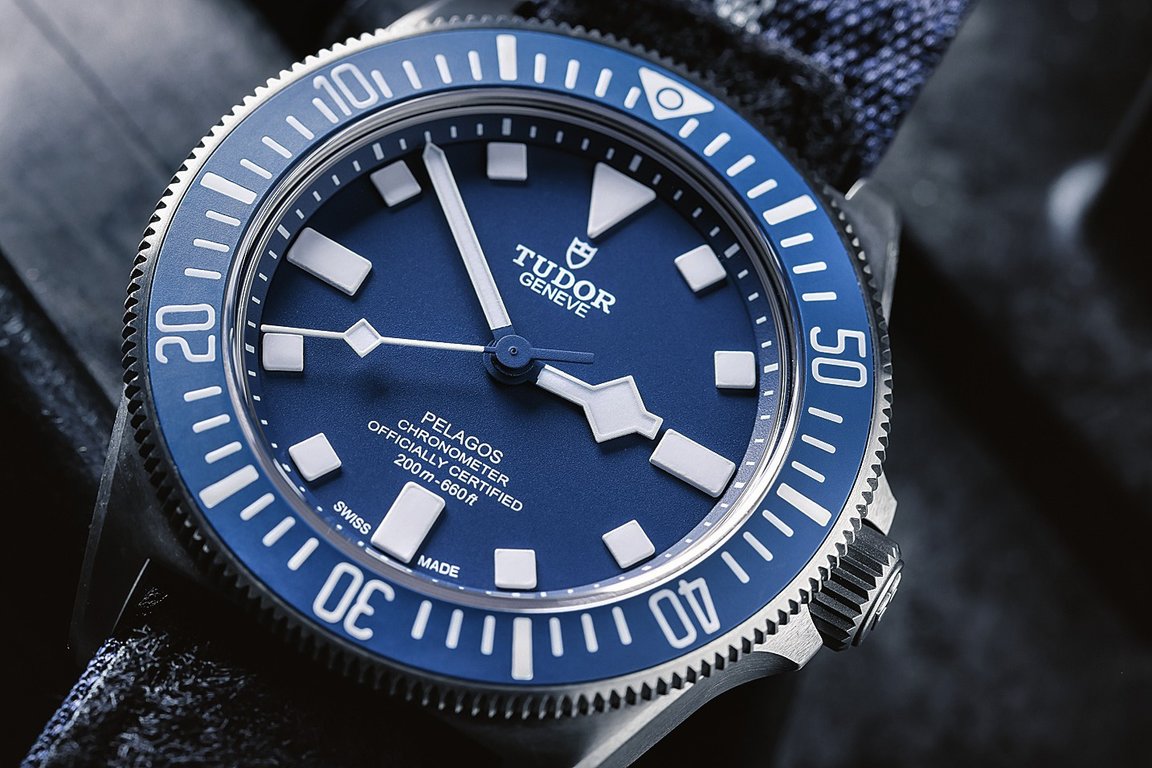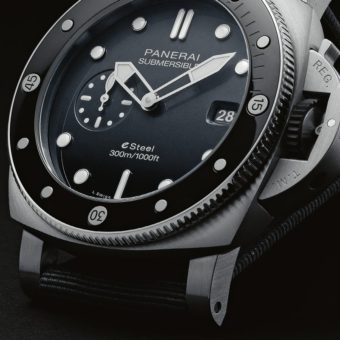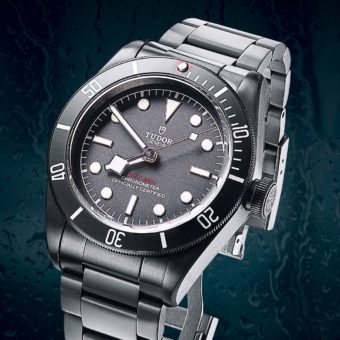This article was originally published in the July/August 2022 Issue of the WatchTime print magazine. Photos by Marcus Krüger.
Tudor has revived its tradition as a supplier to French Navy combat swimmers with a tool watch that incorporates historical design elements while meeting the elite unit’s modern specifications for a navigation instrument.
Since 1960, Tudor has been supplying watches to the combat swimmers of the French Navy, the Marine Nationale. The first models were similar in style to the Rolex Submariner, but since 1974, Tudor’s own design has been used, with the iconic “snowflake” hands and rectangular markers. Shortly thereafter, Tudor changed the black dial to a much more UV-resistant blue color. While the civilian versions usually came with a steel bracelet, the French marines’ watches were supplied without a strap or a bracelet; the military forces provided a textile strap. The caseback was engraved with “M.N.” for Marine Nationale and the year the watch was made. These watches were supplied to the Navy until the 1980s — to the Commando Hubert, their elite combat swimmer unit, to be exact.
The new Tudor Pelagos FXD, our test watch, not only has returned to historical design elements like the blue hue and traditional dial layout, it also has renewed its collaboration with the Marine Nationale combat swimmers. In fact, its design and features were created according to the professional requirements of the elite French “Nageurs de combat” units.

The needs of a combat swimmer differ significantly from those of a recreational diver, which is why the Pelagos FXD is not a dive watch per se. Its bezel can be rotated in both directions and has a countdown track. Its design helps military units, which usually need to approach a target under water without detection and sometimes must identify targets or detonate bridges or ships behind enemy lines. In order to move under water without being detected, these elite forces use special equipment such as closedcircuit rebreathers that prevent bubbles from rising to the surface.
Normally the combat swimmers approach a target in teams of two, at a shallow depth. One diver holds a console with a compass and depth gauge and tracks the route and depth while the other keeps track of the time. Nautical charts are used during preparation and planning to define a route to the target. These routes usually do not follow a direct line, but instead follow the coast at a specified distance. For example, the pair may first swim at a depth of three meters for 10 minutes at a bearing of 170 degrees, then for seven minutes at 110 degrees. The time corresponds to a certain distance because combat swimmers know precisely how fast they are swimming and how far they will travel during a specified time frame. Currents are also taken into consideration here.
Unlike dive watches, this watch is not used to measure dive time but to measure individual sections of a route. The first combat swimmer coordinates the planned time on the bezel track with the minute hand and sets the course for his partner. He checks when the minute hand reaches the zero mark on the bezel, and then sets the next route and the new time frame. In order to make this process as quick as possible, the bezel can be rotated in both directions. So, a unidirectional bezel, which during a dive ensures that even if the bezel is knocked or moved, it will indicate that the diver has less time rather than more, is not useful here. A deviation in one direction or the other is equally undesirable. But since the watch is held directly in front of the swimmer at all times and the swimmers avoid the shoreline and ocean floor, the risk of unintentionally adjusting the bezel is low.

How does this system work for a civilian who buys the Pelagos FXD? If you’re interested in using the watch for diving, it’s better to rely on the standard Pelagos. For everyone else, the bidirectional rotating bezel is a real advantage, and the countdown track marked in half-minute increments helps more for, say, cooking pasta than a unidirectional dive track with minutes that count upward. Fine grooves and the protruding bezel ensure that it is easy to grasp and turn, with clicks almost as rich as on the timepieces from its more famous sibling, Rolex. The crown is also easy to use. Unscrewing it releases it from the winding mechanism and that protects it from damage. Thanks to the stop-seconds mechanism and lack of a date display, and therefore the lack of the “first” crown position, setting the time is simple.
The lack of a date may seem unusual for a modern tool watch, but first of all, French combat swimmers do not need this information, clear readability of the time is most important to them. Secondly, the watch looks better without it and is a more authentic reflection of the Tudor models created for the Marine Nationale in the 1970s. And it’s a matter of taste whether a date display is even necessary on a wristwatch. Legibility — and the Tudor is superior in this regard — is key. In addition to the sharp contrast it offers in daytime lighting, it glows brightly at night thanks to the luminous material, even on the numbers and markers on the rotating bezel.

Since the watch is also vital for combat swimmers to ensure their safe return to land, they want an especially secure strap attachment. The Pelagos FXD name indicates the “fixed” lugs’ security feature, which are milled from the middle part of the case. The French only use singlepiece, NATO-style textile straps that can be pulled through both lugs. Standard spring bars are indeed a weak point, but, in combination with a standard bracelet or strap, have the advantage of breaking before causing any injury to the wrist — even if this risks damage to the watch falling to the ground or being lost in the water. Use of a “single-pass” pull-through strap avoids this problem. On the other hand, both spring bars would have to break in order to lose the watch. In any case, there is little risk of this happening with the Pelagos FXD since the fixed lugs are extremely sturdy. Still, the fixed strap lugs are a minor drawback for regular customers because the watch doesn’t use standard straps or metal bracelet. However, another disadvantage of a pull-through strap — when the strap covers the back of the watch and hides the movement if there is a transparent caseback — doesn’t apply to this watch with its solid caseback. Only the engraved “M.N.” for Marine Nationale, the last two numerals of the year it was made, and the image of an anchor are hidden by the strap.
The textile strap in matching blue with a silver stripe is made using vintage machines and traditional stitching methods and is both lightweight and sturdy. It comes with a hook-andloop closure that is as well made as the rest of the strap and offers the advantage of infinite adjustment on the wrist. The breathable material gives the lightweight titanium watch a snug and comfortable fit.

The other strap that comes with the watch — a very thin yet rather stiff blue rubber strap with a pin buckle — also offers a wide range of adjustment. But it curves away from the wrist at the lugs so it does not look as perfectly matched to the watch as the textile strap. Both straps are easy to attach and exchange since they are simply pulled through the strap bars.
If you open the fully threaded caseback, you can see Caliber MT5602 with an automatic winding mechanism. It comes from the movement manufacturer Kenissi, which was co-founded with Tudor and also supplies movements to Chanel, Breitling, Fortis and other brands. The movement provides both durability and accuracy. Its impressive thickness of 4.99 mm avoids functional problems caused by the minuscule tolerance differences that occur during manufacturing. The balance is secured beneath a bridge rather than a single-sided cock. In addition, a silicon hairspring prevents rate problems caused by centricity issues or deformation after impact.
Other high-quality features include the long power reserve of 70 hours and the free-sprung balance wheel with four regulating screws; the rate is not regulated by changing the active length of the hairspring as is the case with most ETA calibers. Although the decorations on the movement are modest, the rotor is skeletonized, with a sunburst finish and Tudor engraving. The official Swiss chronometer testing agency COSC, which assesses every Tudor movement, guarantees its precise rate. Here, in addition to other criteria, COSC ensures that the average rate deviation remains between -4 and +6 seconds per day. The testing on our electronic timing machine confirms this accuracy. The values in each of the various positions remained close together, at 3 seconds, with an extremely low average deviation of -0.2 seconds per day. During the real-life testing period on the wrist, the Pelagos gained only 0.5 seconds per day.

The price is reasonable at $3,900. But unfortunately, Tudor has begun showing the same tendencies as Rolex — demand has begun to exceed supply. Those who get a watch will be pleased about rising prices.
Overall, the Tudor Pelagos FXD has succeeded in building on the brand’s combat swimmer tradition in design, as well as reviving this history through the functions and case architecture. The result is a modern tool watch with clear advantages, even for the civilians among us.
To learn more about Tudor, click here, and to subscribe to the WatchTime print magazine, click here.






